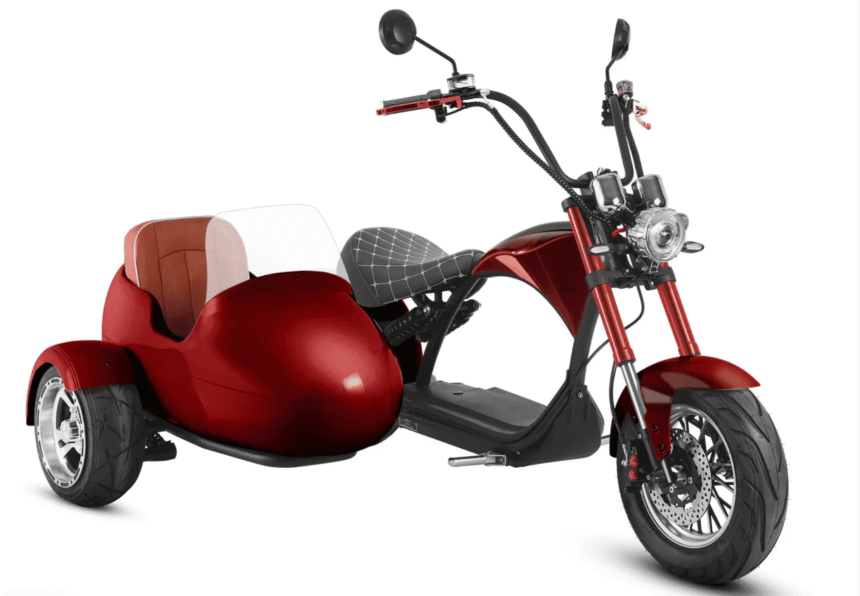As cities worldwide grapple with pollution, traffic congestion, and the rising cost of transportation, the electric scooter with sidecar has emerged as a compelling solution for affordable, efficient, and eco-friendly commuting in 2025. Combining the benefits of electric mobility with the practicality of a sidecar, these innovative vehicles offer an attractive alternative to traditional gas-powered scooters and cars.
Why Electric Scooters with Sidecars Are Gaining Popularity
Electric scooters are already praised for their silent operation, low maintenance costs, and environmental benefits. Adding a sidecar introduces a new dimension, enabling riders to comfortably carry an additional passenger or more cargo with improved stability and safety.
This trend reflects the growing demand for sustainable urban transportation options that do not compromise utility or comfort. Electric scooters with sidecars serve multiple purposes:
-
Family commuting: Safely transport a child or partner.
-
Cargo transport: Carry groceries, deliveries, or work equipment.
-
Ride-sharing: Share rides in urban areas, helping reduce the number of vehicles on streets.
Environmental and Economic Benefits
Electric scooters produce zero tailpipe emissions, helping cities reduce air pollution and carbon footprints. Using an electric scooter with sidecar requires significantly less energy compared to cars, making daily commutes greener and more cost-effective.
Electricity costs for charging are substantially lower than gasoline expenses, which translates into tangible savings for commuters. Moreover, many cities offer incentives, tax rebates, or special parking privileges for electric vehicles, further enhancing accessibility.
Design Innovations in Electric Scooters with Sidecars
Modern electric scooters with sidecars incorporate cutting-edge technology to maximize comfort, safety, and performance. Key features include:
-
Powerful yet efficient electric motors: Deliver smooth acceleration and reach practical city speeds without noise.
-
Battery advancements: Lithium-ion batteries with higher capacity enable longer ranges between charges, typically 40-70 miles.
-
Regenerative braking: Converts kinetic energy back into battery power, extending range.
-
Smart connectivity: Integration with smartphone apps for battery monitoring, GPS tracking, and remote diagnostics.
-
Ergonomic sidecar design: Comfortable seats, weather protection, and safety belts for passengers.
-
Lightweight frames: Using durable materials like aluminum and carbon fiber to keep weight down and improve handling.
Safety Considerations
Electric scooters with sidecars demand some adjustment from riders accustomed to regular two-wheeled scooters. Sidecars alter the vehicle’s dynamics, requiring familiarization with turning, braking, and cornering behaviors unique to the three-wheeled setup.
To enhance safety:
-
Riders should undergo training focused on sidecar handling.
-
Use helmets and protective gear for all occupants.
-
Employ sidecar-specific accessories such as steering dampers and sidecar seat belts.
-
Regular maintenance of brakes, suspension, and battery systems is essential.
Leading Brands and Models in 2025
Innovative manufacturers are actively developing electric scooters with integrated or compatible sidecars. Renowned brands to watch include:
-
Aventura-X: Known for their versatile electric scooters with spacious sidecars suitable for cargo and passengers.
-
NIU Technologies: Pioneering electric scooters designed for urban mobility, with aftermarket sidecar attachments increasingly popular.
-
Vespa Elettrica with sidecars: Iconic Vespa scooter transforms classic design into electric sophistication while accommodating sidecars from specialty manufacturers.
Practical Use Cases and Urban Applications
Beyond daily commuting, electric scooters with sidecars serve niche markets like:
-
Delivery services: Efficient last-mile transport for food or parcel delivery with secure cargo sidecars.
-
Pet transport: Safe, enclosed sidecars designed for small animals.
-
Tourism and rentals: Eco-friendly rental options allowing tourists to explore cities uniquely.
-
Accessible transportation: Modified sidecars accommodate riders with mobility challenges.
How to Choose the Right Electric Scooter with Sidecar
When considering a purchase, evaluate:
-
Range requirements: Match battery capacity to your commute distance.
-
Sidecar purpose: Passenger comfort vs. cargo space.
-
Budget: Electric scooters with sidecars vary from $4,000 on the lower end to $15,000+ for premium models.
-
Charging infrastructure: Ensure convenient access to charging stations or install home chargers.
-
Warranty and support: Select brands with solid after-sales service and spare parts availability.
A High-Authority Resource for Buyers
For in-depth reviews, safety insights, and electric scooter trends, Rider Magazine is a trusted source. Their comprehensive coverage includes electric scooters with sidecars and informs consumers about the latest developments in urban electric mobility.
Visit Rider Magazine for reliable information and expert advice.
Read More: Best Scooter with Sidecar Models of 2025: Top Picks for Riders
Conclusion
Electric scooter with sidecar represent the cutting edge of affordable and sustainable urban transportation in 2025. They address growing commuter needs by offering eco-friendly operation, enhanced passenger and cargo capacity, and a fun, practical riding experience. As innovation continues and infrastructure improves, these vehicles will likely become a mainstream choice for city dwellers seeking efficient mobility without compromising style or functionality.









